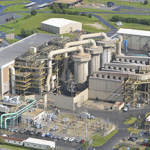Fiberight: A Deep-Dive Into Trash To Find Cash
by Jim Lane. Biofuels Digest
This week Fiberight secured $70 million for a municipal solid waste center that should be in operation by this May. The high-tech facility will convert 180,000 tons of trash each year from more than 100 Maine towns into biofuel at a 144,000-square-foot steel frame facility that began construction last July.
We visually profile the technology and company in our Multi-Slide Guide here.
The underlying facility is what’s known as a Dirty MRF, or materials recovery facility. That’s where the receiving happens and the sortation begins — and the process of recovering value back from the waste stream begins.
The bottom line...
List of Waste-to-Energy Stocks
Waste-to-energy stocks are publicly traded companies whose business involves using municipal or other waste as a feedstock to create fuel or electricity. Organic matter and plastics in a waste stream can be converted to fuel and/or electricity chemically, by means of pyrolysis, biologically such as in anaerobic digestion, or by incineration. Alternatively, energy from waste can be captured from natural processes, such as in the collection of methane gas from landfills.
This list was last updated on 6/23/2021
Active Energy Group PLC (AEG.L)
Attis Industries, Inc. (ATIS)
Babcock & Wilcox Enterprises, Inc. (BW)
BioHiTech Global, Inc. (BHTG)
Blue Sphere (BLSP)
Capstone Microturbine (CPST)
China Recycling Energy Corp....
Earnings Roundup: Metals Prices Boost Covanta and Umicore
By Tom Konrad, Ph.D., CFA
You don’t have to own mining companies to benefit from rising metals prices.
This is a roundup of first quarter earnings notes shared with my Patreon supporters over the last week. Waste to energy operator Covanta and specialty metals recycler Umicore are both benefiting from skyrocketing metals prices.
Just as renewable energy and energy efficiency stocks have long shown that investors don’t have to own fossil fuel companies to benefit from rising prices of fossil fuels, recyclers like Covanta and Umicore are showing that you don’t have to own environmentally damaging mining companies to benefit from rising...
WSTE Not, Want Not
Tom Konrad CFA A truly sustainable economy would produce no waste: everything would be recycled or reused for some productive purpose. We're a long way from that ideal today, but the rising cost of commodities makes recovering used material through recycling increasingly economic. Further, the rising cost of energy makes converting municipal and industrial waste into advanced biofuels or combusting it to produce electricity an increasingly economic option. Attempting to guess which advanced biofuel technology will be successful strikes me as a fool's errand. Why not instead invest in the owners of the feedstock? While I don't...
Casella Back In The Dumps, But Ready To Pick Up?
by Debra Fiakas CFA Casella Plants Flag in Waste-to-Energy The solid waste collection and disposal industry has been transformed by the building enthusiasm for waste recycling. Founded in 1975, Casella Waste Systems (CWST: Nasdaq) has been around to experience a lot of change and has been quick to get on the bandwagon. The company is a self-described recycler and resource manager as well as a solid waste collector. Granted the company is still heavily focused on its conventional solid waste business. Casella management has outlined a four-point plan to grow the company and increase profits. Top on...
Focus On Clean Power Income Trusts
Last week, Tom brought you a piece on the Algonquin Power Income Fund (AGQNF.PK), in which he opined that shift in investor attention away from capital gains toward yield might eventually provide a catalyst for the prices of yield-focused securities such as income trusts to rise. So-called utility trusts, or income trusts where the underlying corporation is engaged in utility activities such as power generation, are a common feature of the Canadian income trust sector (the mother of all income trust sectors). A sub-set of utility trusts is the clean power utility trust, where the power generation...
Darling’s Renewable Diesel Diamond
In July 2013, Darling Ingredients (DAR: NYSE) and its joint venture partner Valero Energy (VLO: NYSE) commissioned the largest facility in North America to convert waste animal fats into renewable diesel. The facility was strategic located adjacent to Valero’s petroleum refining installation in Norco, Louisiana.
At the time the facility was capable of pumping out 12,000 barrels of renewable diesel per day that could be dropped directly into Valero’s distribution network and blended with fossil fuel. Even at that production level the facility showed promise to deliver strong dividends back to its owners. The partners named their venture Diamond Green Diesel and celebrated the unparalleled achievement.
The two partners in Diamond Green...
Plastic Bottle-neck
by Debra Fiakas, CFA
In September 2019, the California State Assembly sent out legislation that sets a 10% recycled plastic mandate by 2021 and increases the hurdle rate to 50% by 2030. The law covers plastic bottles that are already covered under the state’s container redemption program. Companies will need to use plastic bottles made from recycled plastic such that at least a minimum percentage of the plastic used meets the mandate.
Environmentalists and even consumers might be celebrating the new law, but the plastic recycling industry could be less than jubilant. The recycling news feed is peppered with headlines that reveal some fraying...
The Pros Pick Two (Correction:Four) Offbeat Cleantech Stocks for 2014
Tom Konrad CFA Green 2014 image via BigStock Among the dozen stocks picked by my panel of professional green money managers for 2014, most followed three themes: Solar stocks, IT stocks, and income stocks. Two didn’t, and they are included here. This Cash-Rich Water Company Could Produce a Big Dividend The first is a Japanese water utility, picked by Rafael Coven, the Managing Director at the Cleantech Group, and manager of the Cleantech index (^CTIUS) which underlies the Powershares Cleantech ETF (NYSE:PZD.) Coven likes...
Blue Sphere’s Eyes On The Horizon
by Debra Fiakas CFA Renewable energy companies have to worry about flagging commodity prices that make it even more difficult to prove the competitive potential of alternative fuels, as well as possible disruption in the capital markets and valuation multiples which are concerns of all public companies. Shlomi Palas, the CEO of Blue Sphere, Inc. (BLSP: OTC/QB), a microcap in the Crystal Equity Research coverage group, is not dissuaded. He continues to push forward with the company’s strategy to own and operate biofuel-powered, grid-connected generation facilities. Blue Sphere has two food-waste-to-energy plants under construction...
Fulcrum Bioenergy’s $115M IPO: The 10-Minute Version
Jim Lane The first zero-cost feedstock biofuels company comes to the public markets with its IPO. Like to see how this “Back the the Futuresque” technology unlocks value by converting household garbage into transportation fuel? Here’s our 10-minute version of the IPO from Fulcrum Bioenergy. In California, Fulcrum Bioenergy has filed an S-1 registration statement for a proposed $115 million initial public offering. The number of shares to be offered and the price range for the offering have not yet been determined. The company proposes to list under the symbol FLCM. UBS Investment Bank...
Waste Management: Biogas with a Dividend
by Debra Fiakas CFA The biogas industry has attracted a number of new entrants. Blue Sphere (BLSP: OTCQB) described in the recent post “Turning Potato Peels to Power” and RDX Technologies (RDX: TO, described here) are both newcomers to the biogas power generation. Both companies show much promise and will likely grow dramatically over the next few years. Shareholders are counting on the stock prices to follow. Investors who are less interested in the big growth play and more interested in stability and current income are not left out. There are larger, more...
Blue Sphere To Start Biogas Commercial Operations
by Debra Fiakas CFA The Blue Sphere, Inc. (BLSP: OTC/QB), stock price has weakened in recent months as investors registered their apparent frustration with fundamental developments. Proposed acquisitions of operating biogas power plants in Italy have taken much longer than expected and majority interest in planned biogas plants in the U.S. were sold into joint venture arrangements rather than held as 100% equity positions. Despite these developments, Blue Sphere management has doggedly moved forward on all fronts and there has been measurable progress toward first revenue. Commercial operation dates have been set for...
Global Resource Corporation: Needed Technology; Unanswered Questions About Management
On July 3, The Energy Blog told us about a process of turning old tires back into valuable oil and gasses. Given the problems of Peak Oil and plastic waste which can mimic almost anything in the environment, I was intrigued, and I had the feeling that other watchers of the alternative energy space would be, too. After a quick review to make sure that the technology was based on sound science (I believe it is, although that is no guarantee that it can be commercialized), and a search for information about their governance policies and a board list...
Carbon Negative Impacts from Biomass Conversion
By Andrew Grant, Biomass Power Projects, LLC, Lee Enterprises Consulting Canada, New England, and California all have Carbon Credit programs to achieve GHG reduction goals. Several forms of biomass diversion from landfills, farms, and other biomass – dependent GHG sources are already in operation to support significant GHG reductions. Examples of GHG reductions are given, and the carbon impact of the different commercially available biomass to GHG reduction processes are described. The three groups of commercially guaranteed biomass conversion processes are: 1. Power Generation, Steam Generation, and CHP: from the combustion of biomass wastes. This industry, with about 100...
China Recycling Energy: Profiting From Murky Air, But How Much?
by Debra Fiakas CFA Shanghai at sunset as the sun fades into the smog. Photo source: Suicup China’s industrial pollution problems are mounting. Global emissions of carbon dioxide (CO2) increased by 3% in 2011, reaching an all-time high of 34 billion tons. China contributed a whopping 29% of that carbon dioxide - nearly twice that of the second worst polluter, the U.S., which spit out 5.4 million tons or 16% of the total CO2 emissions. Policy makers in China have been slow to move against industrial polluters...






